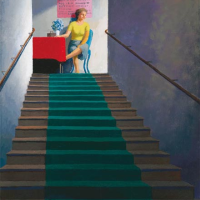35. JEFFREY SMART

Jeffrey Smart loved to paint stairs, they feature in many of his pictures. We can only guess why, but perhaps it was their patterned order and their elevation or sense of spatial progression.
After all, these compositional factors play a consistent role and strengthen the underlying structures of all his well-known paintings of urban road markings, bridges, traffic signs, hoardings, billboards, plazas and freeways. The chosen shapes, shadows and patterns of these pictorial elements visually bind the compositions of his paintings. All of Smarts paintings rest upon very careful and meticulous planning that goes through considerable deliberation - a process of visual refinement - until they possess what Smart called visual weight. That is, they had to mesh into something more and amount to something that moved beyond the mere recording of observations they also had to entice and intrigue.
In other words, Smarts paintings were made rather than simply painted - in a somewhat similar way that a good artistic photograph is made rather than simply taken and a poem is engendered rather than blithely scribbled out. Art photography is not just another snapshot and a good poem is not doggerel - just as a Smart is not just a scene.
Once this is appreciated, Smarts painting Study for Repertory Theatre Entrance 2005 reveals itself as the rare gem that it truly is.
Its all there: one looks deep into the paintings funnelled shapes because it is made to do it. A flight of stairs enlivened by a green carpet, graded out like a paint stores colour chart, leads the viewers eyes upward between two walls, one of which moves up toward the light, while the other moves attention downwards. The resultant play of optical interest is further enhanced by two handrails that channel the sight and focus upon an upper section, lit with angular light, that shows a seated female figure, a cabriole chair, a cash box, a white vase of hydrangeas and a table covered with a red cloth. These elements are placed in front of a candy pink poster of the Shakespeare plays performed by the repertory theatre of the paintings title curiously, Jeffrey Smart has wittily included himself as one of the players.
Looked at as a whole, these varied elements are contained within shapes that control the way that the viewer is led into the picture plane. In its essentials, what one sees is an upper rectangle flanked by two trapezoidal shapes with a central lower trapezoid whose ribbed lines zoom-in upon its principal subject matter. It is as though Smart has concentrated the viewers gaze upon the upper central rectangular area that contains the seated figure in order to better appreciate its balanced finesse and its picture within a picture format. Significantly, the rectangular shape has the dimensions of the Golden Rectangle (1:1.6 the proportions of the common credit-card) Smarts much-used favourite.
Looked at in these ways, Smarts Study for Repertory Theatre Entrance elevates ordinary and generally unnoticed aspects of everyday life into a composition that lifts the mundane in ways that were once, in Medieval and Renaissance times, reserved for religious figures and Royalty. It takes a humble spirit, a generosity of mind and an original eye to carry this off in such an understated manner.
Considered in all these ways, Smarts Study for Repertory Theatre Entrance is typical of two of his artistic gifts: it makes one notice the unnoticed and it elevates the ordinary. Not only that, Smarts carefully considered compositional structure beams out a quiet gravity, it conveys visual weight and, importantly, it is created with the distanced gaze of a very empathetic observer.
Literature
Pearce, B., Jeffrey Smart, The Beagle Press, Sydney, 2005
Capon, E., Jeffrey Smart Retrospective, Sydney, Art Gallery of New South Wales, 1999
McDonald, J., Jeffrey Smart: Paintings of the 70s and 80s, Sydney, Craftsman House, 1990
Quartermaine, P., Jeffrey Smart, Melbourne, Gryphon Books, 1983
Smart, J., Not Quite Straight, Heinemann, Melbourne, 1996
Associate Professor Ken Wach
Dip. Art; T.T.T.C.; Fellowship RMIT; MA; PhD.
Former Principal Research Fellow and Head,
School of Creative Arts
The University of Melbourne